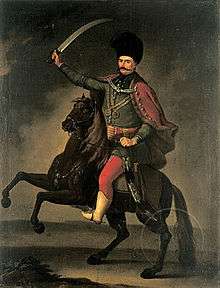Arsenije Teodorović
Arsenije Teodorović (Serbian: Арсен Теодоровић, Perlez, Habsburg Monarchy, 1767 – Novi Sad, Habsburg Monarchy, 13 February 1826) was a Serbian painter from the Banat region of Vojvodina who is widely considered one of Serbia's foremost portraitists.[1] His best known work is the portrait of Dositej Obradović, the father of modern Serbian literature. Shortly before he died, Teodorović bequeathed more than 1,000 paintings to the founder of the Arts and Crafts School of the Metropolitanate of Karlovci, Stefan Stratimirović.[2]
Career

He studied at the Academy of Fine Arts Vienna from 1788 until 1796, and then lived in Timișoara and Novi Sad. He was engaged in portrait painting and painting icons for the sanctuary screens (iconostasis), and he also painted some historical compositions as well.
Teodorović's portrait of Dositej Obradović is considered to be one of the first, modern Serbian civic portraitures. With this portrait, Teodorović placed himself in a Serbian Biedermeier school that include Pavel Đurković, Nikola Aleksić, Konstantin Danil, Jeftimije Popović (1791–1832) and others.[3][4] Portraits of writer Avram Mrazović,[5] merchant Gavrilo Bozitovac (1819), priest Simeon Kojić and his wife Makrena Kojić (1825),[6] and bishop Kiril Živković[7] are further examples of Arsenije Teodorović's masterly style. He even more clearly exhibited his classicist tendencies painting his icons and his allegorical and historical compositions. In Sremski Karlovci Teodorović managed the Drawing School, through which he significantly influenced the next generation of artists.[8]
Portraits of writer Avram Mrazović,[5] merchant Gavrilo Bozitovac (1819), priest Simeon Kojić and his wife Makrena Kojić (1825), and bishop Kiril Živković[7] are further examples of Arsenije Teodorović's masterly style. He even more clearly exhibited his classicist tendencies painting his icons and his allegorical and historical compositions. As far as it is known today, he authored 26 sanctuary screens that still can be found in Serbian Orthodox churches throughout Hungary, Romania, Croatia and Serbia:[9]Baja, Hungary, 1793; Futog, 1798; Pakrac, 1800; Vršac, 1808; Sânnicolau Mare, 1809; Buda, 1810; Saravale, 1811; Novi Sad, 1811;[10] Sremska Mitrovica, 1815; Zrenjanin, 1817; Bavanište, 1818; Mol (Ada) and others.[11]
Works
His work can be found today at art museums and churches:
See also
- List of painters from Serbia
- Serbian art
- Janko Halkozović
References
- Janicevic, Vladimir. "ISTORIČAR UMETNOSTI: WHO IS WHO IN SERBIAN ART".
- "Историјски часопис", Београд 3/1952. године
- Deliso, Christopher (30 December 2008). "Culture and Customs of Serbia and Montenegro". ABC-CLIO – via Google Books.
- "Неокласицизам".
- "Avram Mrazović". 20 February 2018 – via Wikipedia.
- srpske, Galerija Matice (2 January 1974). "Galerie de la Matica srpska: la peinture serbe aux XVIIIe et XIXe siecles". Matica srpska – via Google Books.
- "Neoclassicism Of The 19th Century". www.galerijamaticesrpske.rs.
- "Просветни гласник", Београд 1942. године
- "Београдске новости", Београд 1917. године
- "Almaška Church". City of Novi Sad. Retrieved 1 January 2019.
- "Свеске" Друштва историчара уметности Србије, Београд 1980. године
- "The Town Museum of Sombor – History of Art". gms.rs.
- Theodoré (22 May 2011). "The Art History Journal: Arsenije Teodorović – Арсеније Теодоровић".
- "Arte – Arsenije Teodorović – Portfolio". www.arte.rs.
Literature
- St. Todorović, O srpskom slikaru Arsi Teodoroviću, Naše doba 1882 - 14
- V. Stajić Novosadske biografije V Novi sad 1940 (153-156)
- M. Kolarić, Klasicizam kod Srba, Beograd 1965 (93-98)
- Tekst dr Midraga Kolarića za Enciklopediju Jugoslavije JLZ Zagreb 1972